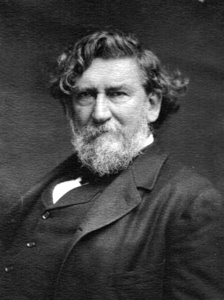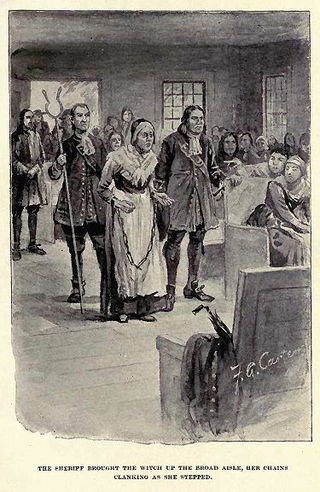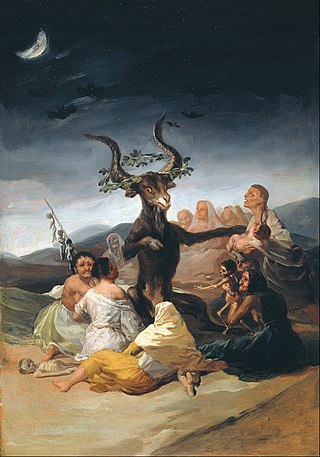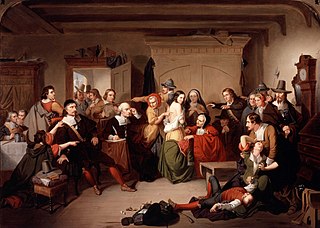
The Crucible is a 1953 play by the American playwright Arthur Miller. It is a dramatized and partially fictionalized story of the Salem witch trials that took place in the Province of Massachusetts Bay from 1692 to 1693. Miller wrote the play as an allegory for McCarthyism, when the United States government persecuted people accused of being communists. Miller was questioned by the House of Representatives' Committee on Un-American Activities in 1956 and convicted of contempt of Congress for refusing to identify others present at meetings he had attended.

The Salem witch trials were a series of hearings and prosecutions of people accused of witchcraft in colonial Massachusetts between February 1692 and May 1693. More than 200 people were accused. Thirty people were found guilty, nineteen of whom were executed by hanging. One other man, Giles Corey, died under torture after refusing to enter a plea, and at least five people died in the disease-ridden jails.
Abigail Williams was an 11- or 12-year-old girl who, along with nine-year-old Betty Parris, was among the first of the children to falsely accuse their neighbors of witchcraft in 1692; these accusations eventually led to the Salem witch trials.

A witch's mark, devil's mark or stigma diabolicum was a bodily mark that witch-hunters believed indicated that an individual was a witch, during the height of the witch trials. The beliefs about the mark differed, depending on the trial location and the accusation made against the witch. Use of the term is found earliest in the 16th century, and reaching its peak in 1645, but then essentially disappearing by 1700.

Samuel Parris was a Puritan minister in the Province of Massachusetts Bay. Also a businessman and one-time plantation owner, he gained notoriety for being the minister of the church in Salem Village, Massachusetts during the Salem witch trials of 1692. Accusations by Parris and his daughter against an enslaved woman precipitated an expanding series of witchcraft accusations.

Tituba was an enslaved Native American woman who was one of the first to be accused of witchcraft during the Salem witch trials of 1692–1693.

Bridget Bishop was the first person executed for witchcraft during the Salem witch trials in 1692. Nineteen were hanged, and one, Giles Corey, was pressed to death. Altogether, about 200 people were tried.

Sarah Good was one of the first three women to be accused of witchcraft in the Salem witch trials, which occurred in 1692 in colonial Massachusetts.

Martha Corey was accused and convicted of witchcraft during the Salem witch trials, on September 9, 1692, and was hanged on September 22, 1692. Her second husband, Giles Corey, was also accused and killed.

Thomas Satterwhite Noble was an American painter as well as the first head of the McMicken School of Design in Cincinnati, Ohio.

Susannah Martin was one of fourteen women executed for the suspicion of practicing witchcraft during the Salem witch trials of colonial Massachusetts.

Rebecca Nurse was a woman who was accused of witchcraft and executed by hanging in New England during the Salem Witch Trials of 1692. She was fully exonerated fewer than twenty years later.
Alse Young of Windsor, Connecticut — sometimes Achsah Young or Alice Young — was the first recorded instance of execution for witchcraft in the thirteen American colonies. She had one child, Alice Beamon (Young), born in 1640, who was also condemned for the same crime thirty years later in the 1670s, but was not hanged.

Cultural depictions of the Salem witch trials abound in art, literature and popular media in the United States, from the early 19th century to the present day. The literary and dramatic depictions are discussed in Marion Gibson's Witchcraft Myths in American Culture and see also Bernard Rosenthal's Salem Story: Reading the Witch Trials of 1692
George Jacobs Sr. (1609–1692) was an English colonist in the Massachusetts Bay Colony who was accused of witchcraft in 1692 during the Salem witch trials in Salem Village, Massachusetts. He was convicted and hanged on August 19, 1692. His son, George Jr., was also accused but evaded arrest. Jacobs' accusers included his daughter-in-law and granddaughter, Margaret.
Elizabeth Howe was one of the accused in the Salem witch trials. She was found guilty and executed on July 19, 1692.
Abigail Faulkner, sometimes called Abigail Faulkner Sr., was an American woman accused of witchcraft during the Salem witch trials in 1692. In the frenzy that followed, Faulkner's sister Elizabeth (Dane) Johnson (1641–1722), her sister-in-law Deliverance Dane, two of her daughters, two of her nieces, and a nephew, would all be accused of witchcraft and arrested. Faulkner was convicted and sentenced to death, but her execution was delayed due to pregnancy. Before she gave birth, Faulkner was pardoned by the governor and released from prison.

Witches' Sabbath is a 1798 oil painting on canvas by the Spanish artist Francisco Goya. Today it is held in the Museo Lázaro Galdiano, Madrid. It depicts a Witches' Sabbath.
The witch trials in Connecticut, also sometimes referred to as the Hartford witch trials, occurred from 1647 to 1663. They were the first large-scale witch trials in the American colonies, predating the Salem Witch Trials by nearly thirty years. John M. Taylor lists a total of 37 cases, 11 of which resulted in executions. The execution of Alse Young of Windsor in the spring of 1647 was the beginning of the witch panic in the area, which would not come to an end until 1670 with the release of Katherine Harrison.

The Examination of a Witch is a painting by T. H. Matteson. There are two versions of the painting, one in the Peabody Essex Museum in Salem, Massachusetts, the other in the Portrait Gallery of the Darwin R. Barker Museum.













